What to Consider When Planning A Fire Pit
By: Lauren M. Liff for Dabah Landscape Designs
The definition of an outdoor space is changing drastically as the years pass; it has gotten to a point where simply having a deck and a grill just won’t cut it. Backyards everywhere are becoming much more detailed and full of “accessories”. From outdoor kitchens to outdoor living rooms complete with fireplaces and detailed stonework designed to look like elegant area rugs. As backyards everywhere are being transformed, the number one fixture being implemented into almost every outdoor design is the fire pit. If you are thinking about adding a fire pit to your outdoor space, here are several things to keep in mind:
1. What is your budget? When planning the design of your fire pit, you want to keep your budget in mind. Fire pits can be all different shapes and sizes and can be made of a variety of materials; the cost of a fire pit can range anywhere from $200.00 and up. If you are building a small fire pit, you can buy the stones and dig the hole yourself or buy a simple fire pit unit from a retailer to keep the cost low. The cost can obviously get increasingly high depending on the sophistication of your fire pit.
2. Will it be permanent or portable? Are you looking for a fire pit that will become the focal point in your yard or do you want to be able to bring the fire pit along with you to a gathering? For a built-in design, the materials should match either your home or other materials in your garden so that everything can flow together smoothly. Portable fire pits come in a wide variety of materials and shapes. There are fire bowls, fire tables and also chimney-style options as well. Whatever style you chose, make sure to use to proper stones and materials for your fire pit to work safely.
3. Will it use wood or gas? Wood and gas are the most common choices for fueling a fire pit. If you are looking for that all too familiar true fire pit smell, then wood is the way to go – just make sure your fire pit has a screen. If you don’t care if you have that smell or not, or you want a quick starter, you can go with gas or propane. Some of these fire pits have remote start capabilities. The fire from a gas-fueled pit won’t be as hot as a wood fire; you also won’t hear the crackling or get that smoke that comes from a wood fire.
4. Where will it be placed? When placing a portable fire pit, it is best to use it on a natural surface – concrete, stone, grave, or brick (for example) will work fine. Embers could fly from your fire pit and could start a fire if not placed on the proper surface. Permanent fire pits are typically built on a gravel base. The fire pit should be built so that it is proportional to the size of your yard and will allow for seating and proper air circulation. In terms of its location in the yard, most areas have a requirement that the fire pit must be at least 10 feet from the home and neighbors’ yards. Permits are sometimes needed for larger fire pits and some require a site inspection to make sure that the location is safe for a fire pit. Before building your fire pit make sure to check your local ordinances to see what is required.
Whether you decide to build your fire pit with a premade kit from a local retailer or you opt to have a landscape professional design and install it, it’s always important to plan thoroughly before beginning the installation process. When it comes to your fire pit, you want to think “safety” above all else.
Safety Tips:
1. Check wind direction before lighting a fire
2. Don’t use flammable fluids to light/relight fires
3. Don’t ware flammable clothing (nylon) or anything loose-fitting
4. Avoid using soft woods (pine/cedar) – they can “pop” and throw sparks
5. Keep children and pets at least 3 feet away from the fire




























